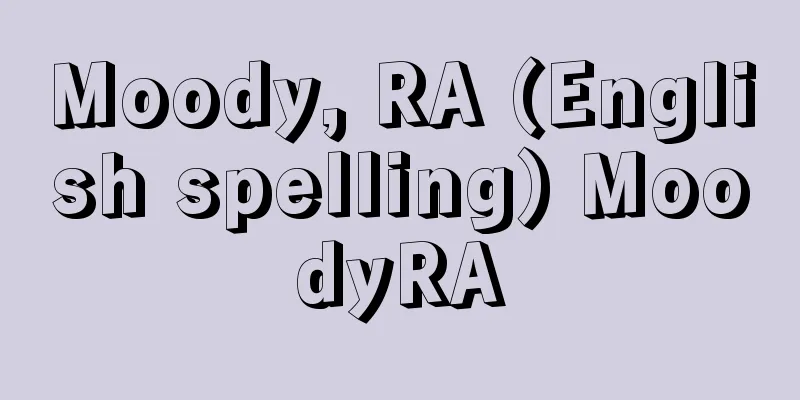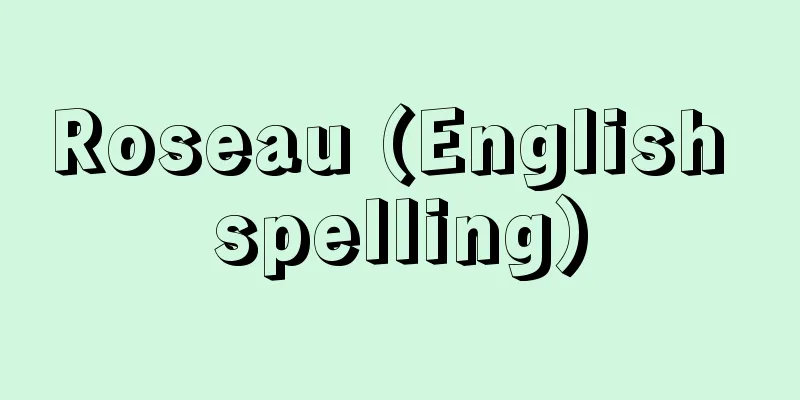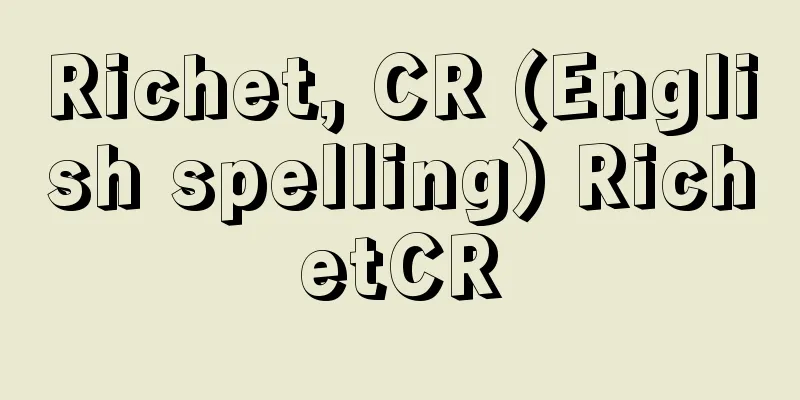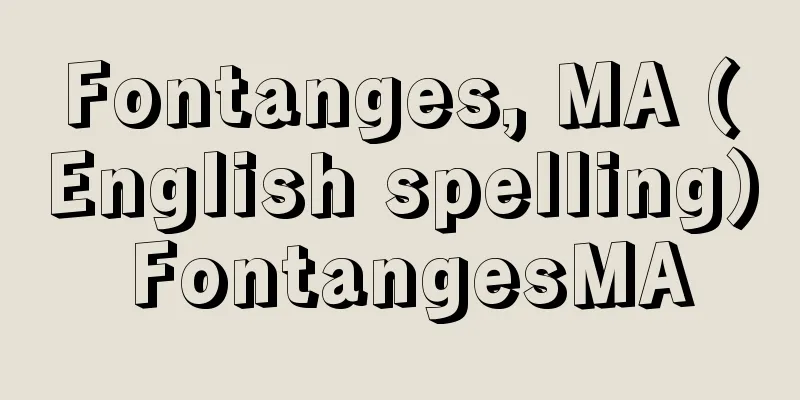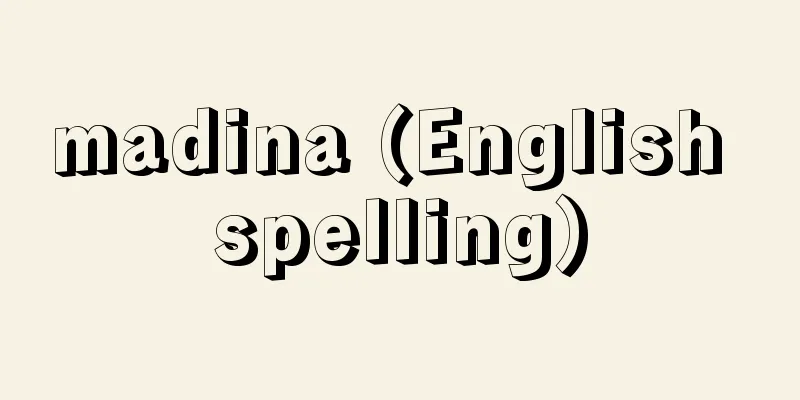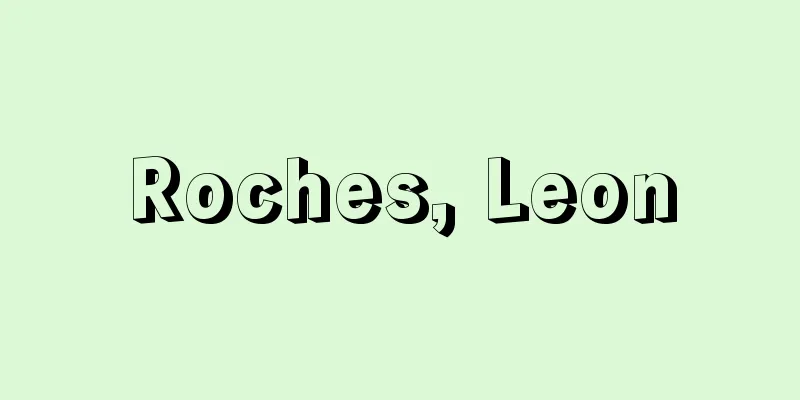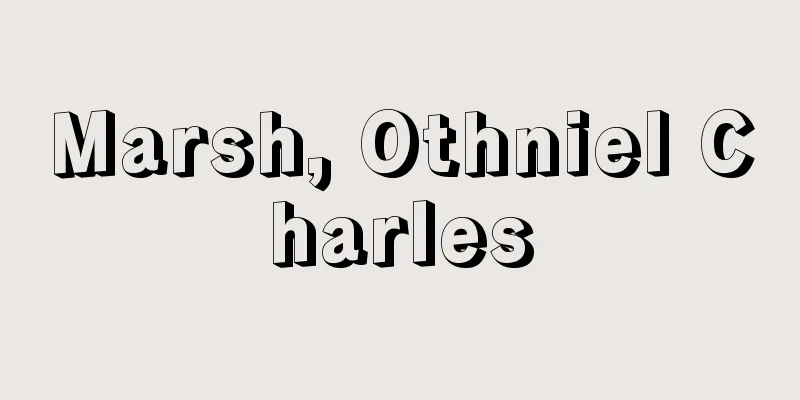Serbia (English spelling) Republic of Serbia
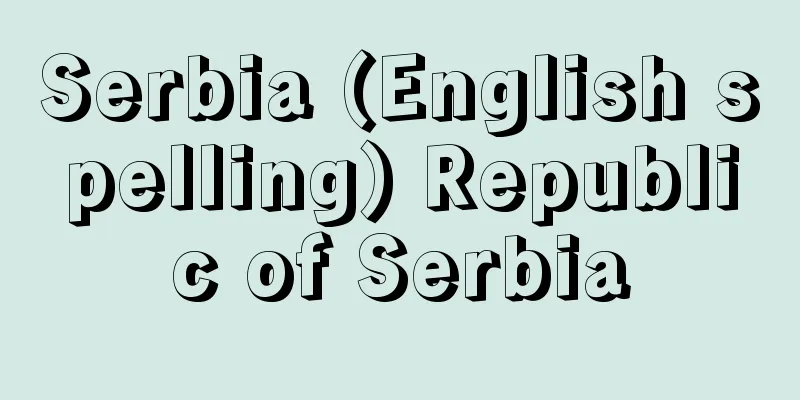
|
A republic located in the southeastern part of Europe, on the Balkan Peninsula. Its official name is the Republic of Serbia. In Serbian, it is Srbija. It borders Hungary to the north, Romania to the northeast, Bulgaria to the east, the Republic of North Macedonia and Kosovo to the south, and Croatia, Bosnia and Herzegovina, and Montenegro to the west. Its area is 88,361 square kilometers (77,474 square kilometers excluding Kosovo), and its population is 7,479,437 (2002 census, excluding the Autonomous Province of Kosovo), approximately 9.4 million (2006 estimate, including Kosovo under the UN interim administration). Its capital is Belgrade. The Republic of Serbia has two autonomous provinces, Vojvodina in the north and Kosovo in the south (however, the Autonomous Province of Kosovo declared independence from Serbia in February 2008 as the "Republic of Kosovo", and although the European Union (EU) and the United States recognized its independence, Serbia does not recognize it). It was originally one of the six republics that made up the Socialist Federal Republic of Yugoslavia (former Yugoslavia), and from 1992 it was part of the Federal Republic of Yugoslavia (new Yugoslavia) together with Montenegro. In February 2003, however, under the new constitution (constitutional charter), the two republics gained significant administrative power, and the country was renamed Serbia and Montenegro. It subsequently became a constituent republic of the federal state of Serbia and Montenegro. However, Montenegro has long had a strong desire for independence, and its currency, economy, and legal system are different from those of Serbia. In May 2006, a referendum was held on whether to become independent, and independence was decided by a majority vote, and independence was declared in June of the same year. Thus, following Montenegro's separation from the federal state of Serbia and Montenegro and its independence as the Republic of Montenegro, in June of the same year, Serbia became the independent state of the Republic of Serbia, the successor state to Serbia and Montenegro. The majority of the population is Serbian, but the country is made up of many other ethnicities, including Albanians, Hungarians, Croats, Montenegrins, and Roma. The first official language is Serbian, but many other languages are spoken, including Montenegrin, Bosnian, Hungarian, Albanian, Roma, Croatian, Slovak, and Romanian. The majority of the population are Serbian Orthodox Christians, with other religions including Catholics, Muslims, and Protestants. The Danube River runs through the north of the country, forming part of the Great Hungarian Plain. The Tisza River basin in particular is the lowest area of the plain, and is frequently subject to flooding. The central part is made up of the lowlands of the Morava River basin and the plateaus of the Rhodope Shield. The southeastern part is structurally part of the Carpathian Mountains, and the Danube River crosses many gorges, including the Iron Gates Gorge, where large-scale hydroelectric power generation is carried out. With a warm continental climate, the plains are one of Serbia's leading grain-producing regions, and corn, wheat, and sunflowers are cultivated there. Serbia has extremely high agricultural production. The country is blessed with abundant resources of copper, zinc, antimony, gold, and silver, and the machine tool, automobile, electrical appliance, and chemical industries are thriving. [Kazuko Urushibara] historyThe Serbs settled in the region in the early 7th century. From then until the 12th century, various Župans (chiefs) fought each other. Lacking internal unity, the region was easily influenced by external forces, and was briefly under Bulgarian rule, but was generally governed by the Byzantine Empire. Religiously, the region also came under the influence of the Eastern Orthodox Church in the late 9th century, due to the missionary work of Cyril and Methodius, who were requested by the Byzantine emperor. In 1168, Stefan Nemanja (reigned 1168-1196) took advantage of the internal conflicts of the Byzantine Empire to escape from its influence and founded the Nemanjan dynasty, which ruled Serbia for about 200 years. His successors worked hard to unify the country, expand its territory, and develop its economy. The period of King Stefan Dušan (reigned 1331-1355) was the peak of the Serbian Empire, and his territory covered almost the entire southern part of the Balkan Peninsula, approaching that of the Byzantine Empire. However, the Battle of Kosovo in 1389 marked the decisive advance of the Ottoman Turks into the Balkans, and Serbia was ruled by the Ottoman Empire for over 400 years. Under the long rule of the Ottoman Empire, Serbs maintained their national identity through the Serbian Orthodox Church and their national epic, and in the early 19th century, they led other Balkan nations in two uprisings against the Ottoman Empire (1804-1813, 1815). As a result, in 1830 Serbia became a principality with complete autonomy. In 1878, Serbia's formal independence as a kingdom was recognized by the Treaty of Berlin after the Russo-Turkish War, and it has since developed into a modern nation. In the 20th century, relations with the Habsburg Empire (Austro-Hungarian Empire) deteriorated, which led to World War I. After World War I, in 1918, it became the center of the "Kingdom of Serbs, Croats and Slovenes" (renamed the Kingdom of Yugoslavia after 1929). [Yoshihiro Shiba] From Yugoslavia to Serbia and Montenegro, and to 21st century SerbiaThe unified South Slavic nation of the Kingdom of Serbs, Croats and Slovenes was founded under King Aleksandar of the Karadjordjevic dynasty of the Kingdom of Serbia, and politically, a centralized system was established with Serbia at the center. As a result, conflict with Croatia, which advocated decentralization, became prominent. The conflict between the two nations continued as the largest ethnic conflict in Yugoslavia. In 1941, when Yugoslavia was invaded by the Axis forces, including Germany, Serbia was occupied by Germany and a puppet government was established. In response, Serbian soldiers who refused to surrender in the Yugoslav army formed a Chetnik unit under Draža Mihailović (1893-1946) and began a resistance movement by barricading themselves in the mountains. However, before they could carry out a concrete resistance movement, the Chetniks began to cooperate with the German army and were unable to expand their influence. In October 1944, the partisan resistance against the Germans finally won a victory, and the capital, Belgrade, was liberated. In November 1945, the Federal People's Republic of Yugoslavia (officially called the Socialist Federal Republic of Yugoslavia in 1963, the former Yugoslavia) was established with Tito as its leader, and Serbia became the largest republic by population, with two autonomous provinces, Vojvodina and Kosovo. Decentralization was promoted under the self-managed socialist system after the Second World War, but until the 1960s, Serbian Aleksandar Ranković (1909-1983) was in charge of the internal affairs authorities, and the centralized nature of the country continued. After Ranković was expelled, liberalization policies were promoted in the late 1960s. The "Constitution of '74" (the Yugoslav constitution revised in 1974) recognized the "economic sovereignty" of six republics and two autonomous regions, and introduced a loose federal system. In the 1980s, the "economic crisis" and the prolonged separatist problem of Kosovo Albanians seeking republic status led to growing dissatisfaction with the "Constitution of '74" in Serbia, with people calling for a stronger federal system. Against the backdrop of growing Serbian nationalism, Milošević emerged as the leader of Serbia. At the end of the 1980s, Serbia and Slovenia were at odds over whether to strengthen the federal system or move to an even looser national federation. As the former Yugoslavia was heading towards disintegration, the League of Communists, which renamed itself the Serbian Socialist Party, won a free election in 1990. Even as the former Yugoslavia was disintegrating, both Serbia and Montenegro maintained their stance of maintaining the federation. In June 1991, Slovenia and Croatia declared independence, and the Yugoslav conflict, which was accompanied by a civil war, began. In January 1992, both countries were recognized by the EU (European Community), and the Socialist Federal Republic of Yugoslavia was essentially dissolved, with Slovenia, Croatia, Macedonia (now the Republic of North Macedonia), and Bosnia and Herzegovina becoming independent. In April of the same year, Serbia and Montenegro declared the establishment of the Federal Republic of Yugoslavia (New Yugoslavia), which would succeed the former Yugoslavia. After Milošević became Chairman of the Presidium of the Republic of Serbia in 1987 and seized real power, he also served as President of the Republic of Serbia (1992-1997) in 1992 and as President of the New Yugoslav Federation in 1997. The Bosnian civil war ended in 1995, but under the Milosevic regime, New Yugoslavia was unable to return to the international community even in 1998. As the economy continued to stagnate, the Kosovo issue and the increasingly independent Republic of Montenegro came to the fore. In particular, the Kosovo conflict arose, in which the Albanian majority in the Autonomous Province of Kosovo sought independence. Peace negotiations were held with the international community, including the United Nations, the United States, and the EU, acting as mediators. However, the Milosevic regime rejected the final peace plan, and in March 1999 the international community launched a "humanitarian intervention," and New Yugoslavia was bombed by NATO (North Atlantic Treaty Organization) forces, causing great damage. In the Autonomous Province of Kosovo, where the Federal Army of New Yugoslavia was deployed, a large number of Albanian refugees were generated. In June of the same year, Milošević accepted the peace plan proposed by the G8 (Group of Eight), and the New Yugoslav Federal Army withdrew from Kosovo. The 78-day air bombing ceased, and the Kosovo Peace Treaty was established, but Milošević was indicted as a war criminal for anti-humanitarian acts and mass murder by the International War Crimes Tribunal in The Hague, Netherlands, during the process. In September 2000, Milošević lost the presidential election in the worst economic situation with continued economic sanctions, and in October the "People's Revolution" collapsed the Milošević regime that had been in power for 13 years, and Koštunica of the Union of Serbian Opposition Parties (DOS) became the new president. In February 2003, the Federal Assembly adopted and promulgated a constitutional charter to reorganize the New Yugoslavia as a federal state, and the country's name was changed to "Serbia and Montenegro." As a result, the name "Yugoslavia" disappeared completely. On the other hand, the Republic of Montenegro, which uses the Euro as its currency and has a different economic and legal system from Serbia, has long had a strong desire for independence. Even after the transition to "Serbia and Montenegro," the country continued to prepare for independence. On May 21, 2006, a referendum on independence was held in Montenegro, with over 55% of voters voting in favor of independence. As a result, a motion in favor of independence was passed by the parliament, and on June 3 of the same year, Montenegro declared independence and became the Republic of Montenegro (the official name became Montenegro in the new constitution of 2007). Following Montenegro's independence, in June 2006, Serbia became the Republic of Serbia as the successor state to "Serbia and Montenegro," and national institutions were reorganized. The Republic of Serbia has a republican political system. The head of state is the president. The first president was Boris Tadic (1958-, term 2004-2012), leader of the Democratic Party. The parliament is unicameral (250 seats), and is made up of the Democratic Party, the Progressive Party, the Socialist Party of Serbia, the Radical Party of Serbia, the Democratic Party of Serbia, and the G17+. The prime minister is Mirko Cvetjovic (1950-, term 2008-2012) of the Democratic Party. The country has made the resolution of the Kosovo issue and EU membership its top priorities, and is working to strengthen ties with European countries. Although the public has a deep-rooted distrust of NATO, the country concluded the "Partnership for Peace" with NATO in 2006. Relations with the EU have also progressed rapidly, with a Stabilization Association Agreement concluded in 2008 and an application for EU membership submitted in December 2009. Economic recovery and improvement of living standards are the country's biggest political issues. [Yoshihiro Shiba] Kosovo Conflict and Independence of KosovoThe Autonomous Province of Kosovo has an area of 10,887 square kilometers, its capital is Pristina. The population is approximately 1.9 million (estimated in 2002), 2.2 million (estimated in 2008), with 88% Albanian, 6% Serb, and 6% other (Bosnian, Roma, Turkish, etc.). The Kosovo conflict has a long historical background, but it is a conflict between the ethnic Albanian residents who seek independence for the autonomous province of Kosovo and the Serbian authorities who do not recognize this. In February 1998, Serbian security forces launched a mopping-up operation against the Kosovo Liberation Army (KLA), an ethnic Albanian armed group seeking independence for Kosovo. This triggered an intensification of armed conflict between the two sides, and the New Yugoslav Federal Army also intervened. The international community showed great interest in this conflict and attempted a political solution. However, the political solution was abandoned, and in March 1999, without a Security Council resolution, NATO, led by the US military, carried out air strikes on Yugoslavia, citing "humanitarian intervention" against the oppression of Albanian human rights by the Milošević regime. In response, the Serbian side also expelled ethnic Albanian residents on a large scale, resulting in a large number of Albanian refugees. In early June of the same year, the Milosevic government accepted the G8 peace plan, and the Kosovo Peace Process was established. Kosovo's autonomy was restored under the management of the United Nations Interim Authority in Kosovo (UNMIK) and international forces led by NATO. Damage believed to be caused by depleted uranium shells used in NATO's air strikes on Yugoslavia (health damage that can lead to leukemia and cancer) became a problem known as the "Balkan Syndrome." After the collapse of the Milosevic regime in 2000, the first autonomous provincial elections were held in 2001, and the Provisional Kosovo Government was established. Under the UN's provisional rule, negotiations between the Serbian and Kosovo governments continued intermittently over Kosovo's final status, but the gap between Serbia, which insisted on the integrity of its territory and would not recognize Kosovo's independence, and Kosovo, which had no choice but to become independent, could not be bridged. After repeated close discussions with the United States, the Kosovo government unilaterally declared independence from Serbia in February 2008. The United States and major EU countries immediately recognized Kosovo as a state, but there was strong opposition from Russia and China, which have similar problems to Kosovo, as well as from other EU countries such as Spain, Greece, and Romania. Without unanimous recognition from the international community, Kosovo remains an "unrecognized state" and is unable to join the United Nations. Japan recognized Kosovo in March of the same year. Serbia maintains effective control over the northern part of Kosovo, and direct negotiations between the Serbian and Kosovo governments are underway under the auspices of the United Nations to resolve the issue. [Yoshihiro Shiba] Economy and IndustryThe currency is the Dinar. The main industries are manufacturing (steel, textiles, rubber products, etc.) and agriculture (fruit, wheat, etc.). The GDP (gross domestic product) is about $40 billion, the GDP per capita is $5,383, the trade volume is about $8.8 billion in exports and $18.4 billion in imports (2007). The main export items are steel, food products such as vegetables and fruits, chemicals, textile products, etc. The main import items are oil, automobiles, machinery, etc. The main trading partners are Russia, Germany, Italy, Bosnia and Herzegovina, etc. (2005). [Yoshihiro Shiba] cultureSince ancient times, various ethnic groups have come and gone, and it has been a complex multicultural country through the former Yugoslavia to the present day. It also has a history as a region where Western European and Eastern Byzantine cultures intersected, and the influence of this remains strong in its cultural heritage. World Heritage sites include Stari Ras and Sopocani, a group of historical monuments that convey the cultural exchange between Western European and Byzantine in the Middle Ages, Studenica Monastery built by S. Nemanja, the founder of the Nemanja dynasty in the 12th century, Medieval Monuments of Kosovo (Heritage in Danger) including Dečani Monastery, Patriarchal Monastery of Pécs, Church of Our Lady of Ljebiša in Prizren, and Gračanica Monastery in Western Kosovo, Gamzigrad Romuliana, Palace of Galerius in eastern Serbia, and the Medieval Necropolis of Steči, which is registered in four countries, Croatia, Bosnia-Herzegovina, and Montenegro. The Decani Monastery is the largest monastery in the medieval Balkan region and is famous for its Byzantine wall paintings. In terms of sports, ball games such as soccer and basketball are popular. In recent years, the country has produced soccer players who have played in Japan's J-League. Stojkovic, who played for Nagoya Grampus Eight, is particularly famous. The club team Red Star (Crvena Svezda) Belgrade has won the Toyota Cup (European/South American Cup). The country is also known as a strong chess nation, with many grandmasters (GMs). [Yoshihiro Shiba] Relations with JapanIt has been a pro-Japanese country since the days of the former Yugoslav Federation, and the Faculty of Linguistics at the University of Belgrade and the Belgrade Language Institute have Japanese language departments, with many people studying Japanese. There are also active clubs throughout the country for Japanese martial arts (aikido, kendo, karate, judo), go, haiku, and more. In March 2011, President Tadić visited Japan. Exports to Japan amounted to approximately 1.1 billion yen, while imports from Japan amounted to approximately 3.2 billion yen (2007). [Yoshihiro Shiba] "What is happening in Yugoslavia?" by Shiba Yoshihiro (1993, Iwanami Booklet) " ▽ "Balkan Nationalism" by Shiba Yoshihiro (1996, Yamakawa Publishing)" ▽ "Encyclopedia of Eastern Europe edited by Ito Takayuki, Naono Atsushi, Hagiwara Nao, and Minamizuka Shingo (1993, Heibonsha)" ▽ "Austria-Hungary and the Problem of Ethnic Minorities: History of the Establishment of the Croatian-Serbian Union" by Tsukimura Taro (1994, University of Tokyo Press)" ▽ "History of Yugoslavia" edited by Clissold, translated by Tanaka Issei, Shiba Yoshihiro, and Takada Toshiaki (1995, Kobunsha)" ▽ "The Bells of Sarajevo" by Andrić, translated by Tanaka Issei (1997, Kobunsha)" ▽ "Fieldwork in the Balkans" by Nakajima Yumi (1997, Taishukan)" ▽ "Balkan Blues" by Ugresic, translated by Iwasaki Minoru (1997, Miraisha)" ▽ "Modern Thought Special Issue: The Disintegration of Yugoslavia" (1997, Seidosha)" ▽ "Fragments of Social History of Croatia and Serbia - Beyond Ethnic History" by D. Roksandic, translated by Koshimura Isao (1999, Sairyusha)" ▽ "The Kosovo Conflict - The Crisis of the Post-Cold War International Order" by Machida Yukihiko (1999, Iwanami Booklet)" ▽ "A Boy from Kosovo" by Nagakura Hiromi (2000, Kaiseisha)" ▽ "From the Depths of Despair to Tomorrow in Kosovo" by Oishi Yoshino (2004, Iwanami Shoten)" ▽ "The Salt of Seeing - A Travelogue of Palestine and Serbia" by Shimoda Inuhiko (2005, Sakuhinsha)" ▽ "Modern History of Yugoslavia" by Yoshihiro Shiba (Iwanami Shinsho) " "The Unending Ethnic Cleansing of Serbia and Montenegro" by Motohiko Kimura (Shueisha Shinsho)" "The Yugoslav Conflict - The Tragedy of a Multi-Ethnic Mosaic Nation" by Zen Senda (Kodansha Gendai Shinsho) [References] | | | | | | | | | | | | | | | | | | | | | | | | | | | | | | | | | | | | | [Supplementary material] |"> Serbia flag ©Shogakukan Illustration/Shogakukan Creative "> Serbia Location Map The capital of Serbia. The photo shows the south side from Kalemegdan Park. Novi Belgrade is on the left bank of the Sava River (right side of the photo). Belgrade, Serbia ©Shogakukan "> Belgrade city Source: Shogakukan Encyclopedia Nipponica About Encyclopedia Nipponica Information | Legend |
|
ヨーロッパ南東部、バルカン半島に位置する共和国。正式名称は、セルビア共和国。セルビア語ではスルビヤSrbija。北をハンガリー、北東をルーマニア、東をブルガリア、南を北マケドニア共和国とコソボ、西をクロアチア、ボスニア・ヘルツェゴビナ、モンテネグロと接する。面積は8万8361平方キロメートル(コソボを除くと7万7474平方キロメートル)、人口747万9437(2002センサス、コソボ自治州は除く)、約940万(2006推計、国連暫定統治下のコソボ含む)。首都はベオグラード。なお、セルビア共和国内には、北部にボイボディナ、南部にコソボの2自治州がある(ただし、コソボ自治州は2008年2月に「コソボ共和国」としてセルビアからの独立を宣言、ヨーロッパ連合(EU)諸国、アメリカなどは独立を承認したが、セルビアは認めていない)。 もともとは ユーゴスラビア社会主義連邦共和国(旧ユーゴスラビア)を構成していた6共和国の一つで、1992年からはモンテネグロとともにユーゴスラビア連邦共和国(新ユーゴスラビア)を構成していたが、2003年2月公布の新憲法(憲法的憲章)に基づき、両共和国の行政権を大幅に拡大した、より緩やかな連合国家へ移行、国名をセルビア・モンテネグロと改称した。その後は、連合国家セルビア・モンテネグロの構成共和国となっていた。しかし、モンテネグロは、かねてより分離独立志向が強く、通貨、経済・法律体制などもセルビアとは異にしており、2006年5月に独立の是非を問う住民投票を実施、賛成多数で独立を決定し、同年6月独立宣言した。こうして、モンテネグロが連合国家セルビア・モンテネグロから離れて、モンテネグロ共和国として独立したことを受け、同年6月セルビアは、セルビア・モンテネグロの承継国である独立国家セルビア共和国となったのである。 住民は、セルビア人が多いが、アルバニア人、ハンガリー人、クロアチア人、モンテネグロ人、ロマなど多民族によって構成される。第一の公用語はセルビア語だが、モンテネグロ語、ボスニア語、ハンガリー語、アルバニア語、ロマ語、クロアチア語、スロバキア語、ルーマニア語など、多くの言語が用いられている。宗教は、セルビア正教徒が多く、ほかにカトリック、イスラム教徒、プロテスタントなどとなっている。 北部はドナウ川が貫流し、ハンガリー大平原の一部をなす。とくにティサ川流域は、この平原のもっとも低い地域に相当し、しばしば洪水にみまわれる。中部はモラバ川流域の低地と、ロドピ楯状地(たてじょうち)に属する高原地帯からなる。南東部は構造的にはカルパティア山脈に属し、ドナウ川による横谷部では鉄門峡をはじめ多くの峡谷があり、大規模な水力発電が行われている。温暖な大陸性気候で、平原部はセルビア屈指の穀倉地帯であり、トウモロコシ、小麦、ヒマワリの栽培が盛んである。セルビアの農業生産はきわめて高い。銅、亜鉛、アンチモン、金、銀の資源に恵まれ、また工作機械、自動車、電器、化学の工業が盛んである。 [漆原和子] 歴史7世紀初頭、セルビア人がこの地方に定住した。以後12世紀に至るまで、さまざまなジュパン(族長)の抗争が続いた。内部の結束を欠いていたので、外部勢力の影響を受けやすく、一時ブルガリアの支配下に置かれたが、概してビザンティン帝国の統治を受けた。宗教的にも9世紀後半に、ビザンティン皇帝の要請を受けたキリロスとメトディオスの伝道活動により、東方正教会の影響下に入った。1168年、ネマーニャStefan Nemanja(在位1168~1196)はビザンティン帝国の内紛に乗じてその勢力下から脱し、セルビアを約200年間支配するネマーニャ朝を創設した。彼の後継者たちは国内の統一、領土の拡大、経済発展に力を尽くした。なかでも14世紀前半、ドゥシャン王Stefan Dušan(在位1331~1355)の時代が最盛期であり、その領土はバルカン半島の南部をほぼ覆い、ビザンティン帝国に迫った。しかし1389年のコソボの戦いを契機として、オスマン・トルコのバルカン進出が決定的となり、以後400年以上にわたり、オスマン帝国の支配を受けた。長いオスマン帝国の統治下で、セルビア人はセルビア正教会や民族叙事詩を通して民族性を保ち、19世紀初頭、他のバルカン諸民族に先んじてオスマン帝国に対し二度にわたる蜂起(ほうき)(1804~1813年、1815年)を企てた。その結果、1830年に完全な自治を有する公国となった。1878年、ロシア・トルコ戦争後のベルリン条約により王国として正式な独立を承認され、以後、近代国家としての発展を遂げる。20世紀に入り、ハプスブルグ帝国(オーストリア・ハンガリー帝国)との関係が悪化し、これが第一次世界大戦を引き起こす原因となった。第一次世界大戦後の1918年、「セルビア人・クロアチア人・スロベニア人王国」(1929年以後、ユーゴスラビア王国と改称)の中心地となった。 [柴 宜弘] ユーゴスラビアからセルビア・モンテネグロ、そして21世紀のセルビアへ南スラブの統一国家「セルビア人・クロアチア人・スロベニア人王国」はセルビア王国のカラジョルジェビッチ王朝のアレクサンダルを国王として、政治的にはセルビア中心の集権体制が築かれた。そのため、分権制を主張するクロアチアとの対立が顕著となった。両者の対立はユーゴスラビア最大の民族対立として継続した。1941年、ユーゴがドイツをはじめとする枢軸軍の侵攻を受けると、セルビアはドイツの占領下に置かれ、傀儡(かいらい)政権がつくられた。これに対して、ユーゴ王国軍のなかでも降伏を受け入れないセルビア人の将兵が、ミハイロビッチDraža Mihailović(1893―1946)のもとにチェトニク部隊を結成し、山岳地に立てこもって抵抗運動に着手した。しかし、チェトニクは具体的な抵抗運動を行わないうちに、ドイツ軍と協力関係をもつようになり、勢力を拡大できなかった。1944年10月、ようやくパルチザンによる対独抵抗運動が勝利を収め、首都ベオグラードが解放された。1945年11月、チトーを首班とするユーゴスラビア連邦人民共和国(1963年からはユーゴスラビア社会主義連邦共和国が正称、旧ユーゴスラビア)が成立し、セルビアはボイボディナとコソボの2自治州をもつ人口最大の共和国となった。 第二次世界大戦後の自主管理社会主義体制下で分権化が進められたが、1960年代までは事実上、セルビア人のランコビッチAleksandar Ranković(1909―1983)が内務機関を統括しており、集権的体質が継続していた。ランコビッチが追放され、1960年代後半には自由化政策が推進された。「74年憲法」(1974年に改正されたユーゴスラビア憲法)により、6共和国と2自治州の「経済主権」が認められ、緩い連邦制が導入された。1980年代の「経済危機」と共和国への昇格を求めるコソボのアルバニア人分離独立問題が長期化するなかで、セルビアでは連邦制の強化を求め、「74年憲法体制」に対する不満が高まっていく。セルビアの民族主義の高まりを背景にして、ミロシェビッチがセルビアの指導者として登場した。1980年代末には、連邦制の強化か、さらに緩い国家連合への移行かで、セルビアとスロベニアが対立した。旧ユーゴが解体へと向かうなか、1990年に行われた自由選挙では、セルビア社会党と改称した共産主義者同盟が勝利を収めた。旧ユーゴが解体していく過程においても、セルビアとモンテネグロはともに連邦維持の立場を貫く。1991年6月スロベニア、クロアチアが独立を宣言し、内戦を伴うユーゴ紛争が始まった。1992年1月には両国がEU(ヨーロッパ共同体)諸国の承認を受け、ユーゴスラビア社会主義連邦共和国が実質的に解体、スロベニア、クロアチア、マケドニア(現、北マケドニア共和国)、ボスニア・ヘルツェゴビナが独立した。同年4月セルビアとモンテネグロは、旧ユーゴを継承するユーゴスラビア連邦共和国(新ユーゴスラビア)の成立を宣言した。ミロシェビッチは1987年にセルビア共和国幹部会議長に就任して実権を掌握して以来、新ユーゴにおいても1992年にセルビア共和国大統領(1992~1997年)、1997年には新ユーゴ連邦の大統領に就任した。 1995年にボスニア内戦が終息したが、ミロシェビッチ政権のもと、1998年に入っても新ユーゴは国際復帰を果たせず、経済不振が継続するなか、コソボ問題と自立傾向を強めるモンテネグロ共和国の問題が表面化した。とくに、コソボ自治州で多数を占めるアルバニア人勢力が独立を求めたコソボ紛争が生じた。国連やアメリカ、EUなど国際社会が仲介し、和平交渉が行われた。しかし、ミロシェビッチ政権が最終的な和平案を拒否したため、1999年3月、国際社会は「人道的介入」に踏み切り、新ユーゴはNATO(ナトー)(北大西洋条約機構)軍の空爆を受け、多大な被害を被った。新ユーゴ連邦軍が展開したコソボ自治州では、大量のアルバニア系住民の難民が発生した。同年6月、ミロシェビッチがG8(ジーエイト)(主要8か国)の提案する和平案を受け入れ、新ユーゴ連邦軍はコソボから撤退した。78日間に及ぶ空爆はやみコソボ和平が成立したが、ミロシェビッチはこの過程でオランダ・ハーグの旧ユーゴ戦争犯罪国際法廷から、反人道的行為や大量殺害の罪で戦犯として起訴された。2000年9月、経済制裁の続く最悪の経済状態のもとでの大統領選でミロシェビッチは敗北、10月の「民衆革命」により、13年に及ぶミロシェビッチ政権は崩壊し、セルビア野党連合(DOS)のコシュトゥニツァが新大統領となった。2003年2月、連邦議会において、新ユーゴスラビアを連合国家として再編するための憲法的憲章が採択、公布されたことにより、国名が「セルビア・モンテネグロ」に変更された。これに伴い、「ユーゴスラビア」という国名は完全に消滅した。 一方、モンテネグロ共和国はユーロを通貨とするなど、経済や法律などの体制もセルビアとは異なり、かねてより独立志向が強かった。「セルビア・モンテネグロ」移行後も、独立に向けて準備を進めた。2006年5月21日、独立の是非を問う住民投票がモンテネグロで実施され、独立賛成票が55%を超えた。この結果、独立賛成案が議会で可決され、同年6月3日にモンテネグロは独立を宣言、モンテネグロ共和国となった(2007年の新憲法で正式名称はモンテネグロとなる)。このモンテネグロの独立を受け、2006年6月セルビアは、「セルビア・モンテネグロ」の承継国としてセルビア共和国となり、国家機関の再編が行われた。 セルビア共和国の政体は共和制。元首は大統領。初代大統領は民主党党首のボリス・タディッチBoris Tadic(1958― 、任期2004~2012)。議会は1院制(定数250)で、民主党、進歩党、セルビア社会党、セルビア急進党、セルビア民主党、G17プラスなどからなる。首相は民主党のツベトコビッチMirko Cvetjovic(1950― 、任期2008~2012)。 コソボ問題の解決とEU加盟を最優先事項とし、ヨーロッパ諸国との関係強化を図っている。NATOに対する国民の不信感は根強いが、2006年にNATOと「平和のためのパートナーシップ」を締結した。EUとの関係も急速に進み、2008年に安定化連合協定を結び、2009年12月に加盟申請を提出した。経済回復、生活の向上が最大の政治課題である。 [柴 宜弘] コソボ紛争・コソボの独立コソボ自治州の面積は1万0887平方キロメートル、州都はプリシュティナ。人口は約190万(2002推計)、220万(2008推計)、民族構成はアルバニア系88%、セルビア系6%、その他(ボスニア人、ロマ、トルコ系など)6%である。 コソボ紛争は、長い歴史的背景をもつが、コソボ自治州の自立・独立を目ざすアルバニア系住民と、それを認めないセルビア当局の争いである。1998年2月、セルビア治安部隊がコソボの独立を目ざすアルバニア系の武装組織であるコソボ解放軍(KLA)に対して、掃討作戦を展開した。これを契機として、両者の武力衝突が激化し、新ユーゴ連邦軍も介入した。国際社会はこの紛争に多大な関心を示し、政治的な解決を目ざした。しかし、政治的な解決は打ち切られ、1999年3月には安保理決議を経ずに、アメリカ軍を中心とするNATOがミロシェビッチ政権によるアルバニア人の人権抑圧に対する「人道的介入」を理由として、ユーゴ空爆を実施した。これに対し、セルビア側も大規模なアルバニア系住民追放を行ったため、大量のアルバニア人難民が発生した。同年6月初め、ミロシェビッチ政権がG8の和平案を受け入れるに至り、コソボ和平が成立した。国連コソボ暫定統治機構(UNMIK)とNATO中心の国際部隊の管理のもとで、コソボの自治の回復が図られた。なお、NATOのユーゴ空爆で使用された劣化ウラン弾によるとみられる被害(白血病や癌(がん)などを発症する健康被害)が、「バルカン症候群」とよばれ問題となった。 2000年にミロシェビッチ政権が崩壊したあと、2001年に初めての自治州議会選挙が行われ、コソボ暫定自治政府が成立した。国連の暫定統治下で、コソボの最終的な地位をめぐり、セルビア政府とコソボ政府との交渉が断続的に続けられたが、領土の一体性を主張してコソボの独立を認めないセルビアと、独立以外の選択肢をもたないコソボとの溝は埋まらなかった。コソボ政府はアメリカと密接な協議を重ねたうえで、2008年2月、セルビアからの一方的な独立を宣言した。アメリカやEUの主要国は、すぐにコソボの国家承認をしたが、コソボと同様の問題をかかえるロシアや中国、EU内のスペイン、ギリシア、ルーマニアなどの反対は強い。国際社会の一致した承認が得られず、コソボは「未承認国家」のままで、国連に加盟できない状態に置かれている。日本は同年3月コソボを承認した。セルビアはコソボ北部地域を実効支配したままであり、国連のもとで、問題解決に向けて、セルビア政府とコソボ政府の直接交渉が進められることになっている。 [柴 宜弘] 経済・産業通貨はディナールDinar。主要産業は、製造業(鉄鋼、繊維、ゴム製品など)、農業(果実、小麦など)。GDP(国内総生産)は約400億ドル、一人当りGDPは5383ドル、貿易額は輸出約88億ドル、輸入約184億ドル(2007)、主要輸出品目は鉄鋼、野菜・果実などの食料品、化学薬品、繊維製品など、主要輸入品目は石油、自動車、機械類など、主要貿易相手国はロシア、ドイツ、イタリア、ボスニア・ヘルツェゴビナなど(2005)。 [柴 宜弘] 文化古来さまざまな民族が往来し、旧ユーゴスラビアを経て今日に至るまで複雑な多文化国家という性格が強い。また、西欧と東方ビザンティンの文化が交わる地域としての歴史をもち、文化遺産にもその影響が色濃く残る。世界遺産の登録地としては、中世の西欧とビザンティンの文化交流を伝える歴史的建造物群「スタリ・ラスとソポチャニ」、12世紀ネマーニャ朝の創始者S・ネマーニャによって建てられた「ストゥデニツァ修道院」、コソボ西部にあるデチャニ修道院、ペーチ総主教修道院、プリズレンのリェビシャの生神女教会、グラチャニツァ修道院を含む「コソボの中世建造物群」(危機遺産)、セルビア東部の「ガムジグラード・ロムリアーナ、ガレリウスの宮殿」、クロアチア、ボスニア・ヘルツェゴビナ、モンテネグロとともに4か国で登録されている「中世墓碑ステチュツィの墓所群」がある。デチャニ修道院は中世バルカン地方最大の修道院でありビザンティン様式の壁画が有名。 スポーツではサッカー、バスケットボールなど球技が盛んである。サッカーでは、近年日本のJリーグで活躍する選手も輩出している。とくに名古屋グランパスエイトに在籍したストイコビッチは有名。クラブチームのレッドスター(ツルベナ・スベズダ)・ベオグラードは、トヨタカップ(ヨーロッパ/サウスアメリカ・カップ)で優勝したことがある。チェスの強国としても知られ多数のグランドマスター(GM)を擁する。 [柴 宜弘] 日本との関係旧ユーゴスラビア連邦時代以来の親日国であり、ベオグラード大学言語学部、ベオグラード語学専門学校には日本語科も設けられ、多くの人々が日本語を学んでいる。また、各地に日本の武道(合気道、剣道、空手、柔道)や囲碁、俳句などのクラブがあり、活発な活動を展開している。2011年3月、タディッチ大統領が訪日した。日本への輸出額は約11億円、日本からの輸入額は約32億円(2007)である。 [柴 宜弘] 『柴宜弘著『ユーゴスラヴィアで何が起きているか』(1993・岩波ブックレット)』▽『柴宜弘著『バルカンの民族主義』(1996・山川出版社)』▽『伊東孝之、直野敦、萩原直、南塚信吾監修『東欧を知る事典』(1993・平凡社)』▽『月村太郎著『オーストリア=ハンガリーと少数民族問題―クロアティア人・セルビア人連合成立史』(1994・東京大学出版会)』▽『クリソルド編、田中一生・柴宜弘・高田敏明訳『ユーゴスラヴィア史』(1995・恒文社)』▽『アンドリッチ著、田中一生訳『サラエボの鐘』(1997・恒文社)』▽『中島由美著『バルカンをフィールドワークする』(1997・大修館)』▽『ウグレシィチ著、岩崎稔訳『バルカン・ブルース』(1997・未来社)』▽『『現代思想臨時増刊・ユーゴスラヴィア解体』(1997・青土社)』▽『D・ロクサンディチ著、越村勲訳『クロアティア=セルビア社会史断章――民族史を越えて』(1999・彩流社)』▽『町田幸彦著『コソボ紛争――冷戦後の国際秩序の危機』(1999・岩波ブックレット)』▽『長倉洋海著『コソボの少年』(2000・偕成社)』▽『大石芳野写真『コソボ絶望の淵から明日へ』(2004・岩波書店)』▽『四方田犬彦著『見ることの塩―――パレスチナ・セルビア紀行』(2005・作品社)』▽『柴宜弘著『ユーゴスラヴィア現代史』(岩波新書)』▽『木村元彦著『終わらぬ「民族浄化」セルビア・モンテネグロ』(集英社新書)』▽『千田善著『ユーゴ紛争――多民族・モザイク国家の悲劇』(講談社現代新書)』 [参照項目] | | | | | | | | | | | | | | | | | | | | | | | | | | | | | | | | | | | | | [補完資料] |"> セルビアの国旗 ©Shogakukan 作図/小学館クリエイティブ"> セルビア位置図 セルビアの首都。写真はカレメグダン公園から南側を望む。サバ川左岸(写真右側)がノビ・ベオグラード。セルビア ベオグラード©Shogakukan"> ベオグラード市街 出典 小学館 日本大百科全書(ニッポニカ)日本大百科全書(ニッポニカ)について 情報 | 凡例 |
<<: Serbocroatian - Serbo-Croatian (English spelling)
>>: Cervantes - Miguel de Cervantes Saavedra
Recommend
Indo-Aryan languages
…a branch of the Indo-European language family. T...
Yasui Sotaro
Born: May 17, 1888 in Shimogyo, Kyoto. [Died] Dece...
Himalayan cuckoo - Himalayan cuckoo
A bird of the Lesser Cuckoo order and Lesser Cucko...
Mint - Dutch mint
…Japanese name: Midori-Hakka. Also known as Dutch...
Katsuso - Katsuso
… [Form of existence of the land tax system] Fixe...
Quesnel, P.
...For political reasons, a compromise called the...
Crab-eating monkey - Crab-eating monkey
An Old World monkey (illustration) of the Cercopit...
Collection of crazy questions and answers - Muchuu Mondoshuu
A collection of sermons in which Muso Soseki answ...
Newspaper single - Shinbuntantsu
The abbreviation for the Japan Newspaper Communica...
Naked Spoon-nosed Bat - Naked Spoon-nosed Bat
…The largest of this family, the common vampire b...
Dementia - dementia
A state in which normally developed intelligence i...
Indonesian Communist Party (English name) Partai Komunist Indonesia
A political party in Indonesia. Founded on May 23,...
Dog God Man - Inujinin
In the Middle Ages, they were subordinate to Gion ...
Aoburi - Aoburi
…Their backs are blue, their abdomens silvery whi...
Meade, James Edward
Born: June 23, 1907, Swansea [Died] December 22, 1...
